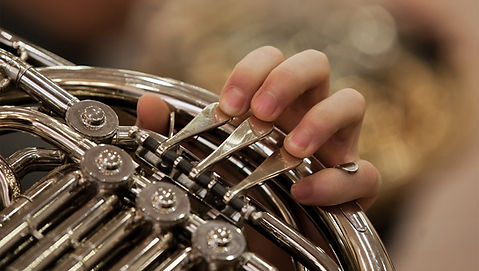
Symphony No. 7 "Symphony for Sam" (2014)
Band/Wind Ensemble (Grade 5-6)

Symphony No. 7 was commissioned by Dan Presgrave and the St. Louis Wind Symphony to honor the life of Sam Goldstein, horn player and founding member of the band who passed away from ALS in 2008. According to Dan, “Sam dearly loved music and his horn. He said on many occasions that he was happiest when he was playing.” Sam particularly loved the powerful horn lines in the music of Gustav Mahler, Ottorino Respighi, Gustav Holst, Howard Hanson, Claude T. Smith, and John Williams.
The concept for this “Symphony for Sam” was inspired by the words of Faye Siegel, a fellow member of the band who spoke at his funeral. Her words described a symphony in which the first movement represents Sam as a Renaissance Man, owner of a local business, champion racquetball player, baseball afficionado, horn player in several ensembles, and thoughtful and intelligent conversationalist. The second movement reflects Sam as a Devout and Compassionate Man; his Jewish faith was important to him, and he could often be found at the synagogue or having discussions related to religion and Jewish heritage. This movement has a quiet, chorale-like beauty to it. The third movement is a playful scherzo; Sam was loved for his quick wit and ability as a Master Story and Joke Teller. And the final movement is Sam as a Passionate and Courageous Man, someone who smiled through the travails of life. According to his wife, “Sam faced his horrible diagnosis of ALS with the same determination and positive outlook” that he had always maintained and “dealt with his condition with humor and grace.” He loved his family and friends more than anything, and several in the band spoke of his willingness to “give you the shirt off his back.” Truly, he was a beautiful soul, and the movement seeks to end the symphony with a triumphant and powerful statement reflective of a man who lived life to the fullest.
The form of Symphony No. 7 is in four continuous movements, connected by three transitional sections that are similar in nature, creating seven sections for the entire piece. The entire symphony is based on a “tonal row” using the seven notes of the E flat major scale, presented initially by the solo horn’s opening statement of F G Eb D Bb Ab C F. This melody is used as the main melodic idea for each and every section of the piece, with any secondary theme in a movement comprised of the retrograde of that same tonal row. Contrast is created between the movements by progressing through each of the seven modes over the course of the symphony, as seen below:
I - Dorian
Transition - Locrian
II - Ionian
Transition - Phrygian
III - Lydian
Transition - Aeolian
IV – Mixolydian
Finally, and perhaps most importantly, the entire work features the horn, beginning with a solo statement, featuring the section in four-part writing at times, and concluding with powerful and majestic unison horn lines, hopefully honoring a great man with music that he himself would have loved to play.
